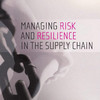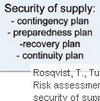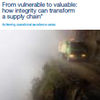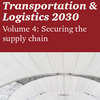 Today’s supply chains circle the globe and form the backbone of world trade and a are major factor in the global economy, linking countries far from us as if they were our neighbors. The world is becoming smaller, no doubt. But this increasingly tighter connected world is also increasingly dangerous, and it thus imperative to secure supply chains against any form of man-made and natural disruption. So say PwC in the lastest volume of their Transportation & Logistics 2030 series: Securing the supply chain. Based on a survey of a global group of experts using the RealTime Delphi method, this well-founded report highlights and explores what elements of supply chain security they believe will be most critical in the future.
Today’s supply chains circle the globe and form the backbone of world trade and a are major factor in the global economy, linking countries far from us as if they were our neighbors. The world is becoming smaller, no doubt. But this increasingly tighter connected world is also increasingly dangerous, and it thus imperative to secure supply chains against any form of man-made and natural disruption. So say PwC in the lastest volume of their Transportation & Logistics 2030 series: Securing the supply chain. Based on a survey of a global group of experts using the RealTime Delphi method, this well-founded report highlights and explores what elements of supply chain security they believe will be most critical in the future.
Chokepoints
One major issue in supply chain security is the vulnerability of so-called “chokepoints”. Using AON’s risk map, the report features a map of important global supply chain links, hubs and associated threats, showing how chokepoints constitute vulnerability hotspots that supply chain managers need to be aware of and take precautions against.
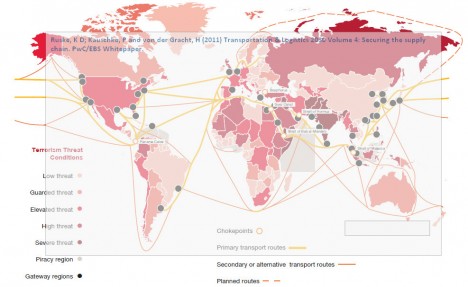 According to the report “chokepoints” are geographic features where there is only one narrow way across a strait, valley or bridge, are another potential weak point. Admittedly, they are right, because disrupting traffic through the Panama Canal, Suez Canal or the Strait of Malacca, for example, would slow down freight flows significantly.
According to the report “chokepoints” are geographic features where there is only one narrow way across a strait, valley or bridge, are another potential weak point. Admittedly, they are right, because disrupting traffic through the Panama Canal, Suez Canal or the Strait of Malacca, for example, would slow down freight flows significantly.
Highlights
The report is focussed around three major topics:
Ensuring secure passage
Where are global supply chains most at risk? Countries that are less stable, either politically or economically are often hot spots. Gateway regions where there are very large flows of cargo are particularly important for global supply chains, and are therefore also of special interest to those looking to disrupt them. We believe that transportation and logistics companies will need to take security concerns into account when choosing transport routes. They’ll need to take a close look at how dependent their business is on particular logistics hubs or chokepoints, and then assess how they can reduce the impact of threats to particular locations. Transportation and logistics companies will also need to be prepared to respond quickly if risk levels change.Keeping cyber space safe
IT systems are becoming more interdependent, as companies connect across their supply chains. While this increases information flow and efficiency, it also means that one successful cyber attack could have disruptive, unpredictable, devastating effects on other systems and companies and cause long-lasting consequences to economies. Consequently, cyber attacks inducing physical damage are an increasing threat for the transportation and logistics industry. The transportation and logistics industry already relies heavily on Information and Communication Technology (ICT), and virtual threats need to be taken just as seriously as physical ones. Indeed, we believe that cyber attacks designed to induce physical damage will be an increasing threat for the transportation and logistics industry.Investing in a more secure future
Enhanced security measures mean higher costs. Does all this emphasis on improving security measures mean profits will decline? Not necessarily. Well-planned security investments provide a payback not only in terms of loss prevention, but also by enhancing supply chain performance. Mind you, additional safety measures also create a range of opportunity costs that might not always be immediately apparent for transportation and logistics companies, i.e. costs incurred through longer transport times, longer dwell times and increased turnaround times.
The report also stresses the importance of industry and government cooperation:
Stricter standards and the need to take the lead
And while they won’t need to go it completely alone, transportation and logistics companies shouldn’t expect government to pick up the slack. We believe that governments won’t take a leading role in executing supply chain security, although they will continue to regulate security measures. Transportation and logistics companies will need to work together with governmental institutions to develop new security standards that are not only effective, but also efficient.
Obviously, there could be other threats, but I believe PwC has hit the nail on proverbial head here.
Wildcards
The report also introduces the notion of “wildcards”, arguing that any look into the future should not be limited to the most probable scenarios though. Unlikely events do sometimes happen – and can have a huge impact on both society and the economy. Such low-probability, high-impact events can be termed “wildcards”:
What if terrorist attacks shut down logistics networks?
Logistics networks are the backbone of the global supply chain. That means disruptions could slow down national economies, making them potentially a preferred target for terrorist attacks. Important hubs, such as seaports and airports, could be shut down by physical aggression.What if insurance companies stop covering major risks?
In the future, insurance companies might refuse to underwrite some types of large risks – for example damage resulting from natural catastrophes, or from terrorist actions. If transportation and logistics companies are no longer able to offset risk through insurance, logistics costs might soar.What if key transit points are blocked?
A large portion of total world trade passes through important transit points such as the Panama Canal, the Suez Canal and the Strait of Malacca. Today the access to such transit points is almost unrestricted. If access to important trade routes were limited or made prohibitively expensive by operators, it could have severe consequences for global trade.What if a super-virus paralyses large ICT systems?
Computer viruses are becoming more sophisticated and are causing greater damage to ICT systems. If a new and more powerful virus was able to infect large ICT systems, it could result in massive system breakdowns. That could potentially shut down a whole range of automated processes, paralysing entire supply chains.What if cryptography doesn’t work anymore?
Imagine what happens if new super computers are powerful enough to crack any cryptography system or password within seconds? Communications in the transportation and logistics industry, customer data, transport routes, freight content and further confidential data would be accessible to competitors, criminals, and other unauthorised parties.
That is certainly more than enough to be worried about.
Critique
I’ve read and reviewed a number of whitepapers and reports for this blog, and honestly, some are better (or worse) researched than others, some seem to be mere infomercials, while others even hold some academic value. This report definitely falls into the latter category: well-researched, well-founded and well-written…and it contains a long list of references well worth further investigation.
Reference
Ruske, K D; Kauschke, P and von der Gracht, H (2011) Transportation & Logistics 2030 Volume 4: Securing the supply chain. PwC/EBS Whitepaper.
Author links
- pwc.com: Klaus-Dieter Ruske
- linkedin.com: Heiko von der Gracht
Related links
- pwc.com: Securing the supply chain
The Transportation and Logistics 2030 series is a foresight publication series that anlayzes future scenarios within the transportation and logistics domain. If you found the above interesting, you may also want to have a look at the other reports:
- pwc.com: How will supply chains evolve in an energy-constrained, low-carbon world?
- pwc.com: Transport infrastructure—Engine or hand brake for global supply chains?
- pwc.com: Emerging Markets – New hubs, new spokes, new industry leaders?
Related posts
- husdal.com: From vulnerable to valuable (another PwC whitepaper)



